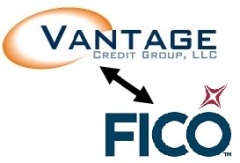VantageScore vs FICO Score
 VantageScore vs FICO Score – which is better? How do they differ, what are the key differences and how to convert VantageScore to FICO score? We’ll try to answer all those questions.
VantageScore vs FICO Score – which is better? How do they differ, what are the key differences and how to convert VantageScore to FICO score? We’ll try to answer all those questions.
VantageScore vs FICO Score – Why two scores?
Do we really need two different scores? Well, no. So why do we have both?
The answer is very simple – MONEY!
FICO score was developed in the 80’s by the Fair Isaac Corp. (hence its name). The Fair Isaac Corp. developed the model, but in order to produce someone’s score you also need data.
This is where the three credit bureaus (Experian, Equifax & Transunion) come into the picture – they collect data. But in order to produce and sell credit scores to lenders they have to pay royalties to Fair Isaac, to use the FICO algorithm…
So, the obvious solution for the 3 credit bureaus was to invent a new type of credit score for themselves, use it instead of FICO and save a lot of royalties’ money.
And so, the VantageScore was born in 2006.
VantageScore vs FICO Score – What are the key differences?
There are 4 key differences between VantageScore and FICO:
VantageScore vs FICO Score Range
FICO score rages between 300 – 850.
The first versions of VantageScore (1.0 & later 2.0) initially ranged between 500 – 990, which made the conversion from VantageScore to FICO almost impossible.
So, in 2013 the 3 credit bureaus launched the VantageScore 3.0 that adopted the 300-850 range used by FICO.
The latest VantageScore 4.0 released in 2017 also uses the 300 – 850 range.
Bottom line: If you wish to convert VantageScore 2.0 to FICO follow this link: Convert VantageScore 2.0 to FICO. No conversion is needed between VantageScore 3.0/4.0 and FICO since they use the same range.
VantageScore vs FICO Score Credit Tiers
Although Fico & VantageScore uses the same range, they impact the lender’s decision differently:
| Range | Rating | % of People | Impact |
|---|---|---|---|
| 800 – 850 | Exceptional | 21% | Applicants with scores in this range are at the top of the list for the best rates from lenders |
| 740 – 799 | Very Good | 25% | Applicants with scores here are likely to receive better than average rates from lenders |
| 670 – 739 | Good | 21% | Only 8% of applicants in this score range are likely to become seriously delinquent in the future |
| 580 – 669 | Fair | 17% | Applicants with scores in this range are considered to be subprime borrowers |
| 300 – 579 | Very Poor | 16% | Credit applicants may be required to pay a fee or deposit, and applicants with this rating may not be approved for credit at all |
| Range | Rating | % of People | Impact |
|---|---|---|---|
| 781 – 850 | Exceptional | 23% | Applicants most likely to receive the best rates and most favorable terms on credit accounts |
| 661 – 780 | Good | 38% | Applicants likely to be approved for credit at competitive rates |
| 601 – 660 | Fair | 13% | Applicants may be approved for credit but likely not at competitive rates |
| 500 – 600 | Poor | 21% | Applicants may be approved for some credit, though rates may be unfavorable and with conditions such as larger down payment amounts |
| 300 – 499 | Very Poor | 5% | Applicants will not likely be approved for credit |
VantageScore vs FICO Scoring Factors
This is where VantageScore differ from FICO. Since they use different models, each put different weights on different data types.
| Payment history | 35% |
| Level of debt/amounts owed | 30% |
| Age/length of credit history | 15% |
| Types of credit/credit mix | 10% |
| Credit inquiries/new credit | 10% |
| Payment history | 40% |
| Age and type of credit | 21% |
| Percent of credit used | 20% |
| Total balances/debt | 11% |
| Recent credit behavior and inquiries | 5% |
| Available credit | 3% |
VantageScore 4.0 changes the scoring criteria a bit:
| Payment history | 41% |
| Age and type of credit | 20% |
| Percent of credit used | 20% |
| Recent credit behavior and inquiries | 11% |
| Total balances/debt | 6% |
| Available credit | 2% |
VantageScore vs FICO Score – Which is better?
From a consumer’s standpoint, the better credit score to consider is the one your prospective lender is using to approve or decline your application.
More lenders are using the FICO Score, but you shouldn’t assume that. Always ask your lender which credit score they’ll be checking, and which version.
Remember that many sites that offer free credit scores are using old versions of FICO or VantageScore, so the free credit scores they offer probably won’t match the one the lender receives.
